November 28, 2025 | 01:08 GMT +7
November 28, 2025 | 01:08 GMT +7
Hotline: 0913.378.918
November 28, 2025 | 01:08 GMT +7
Hotline: 0913.378.918
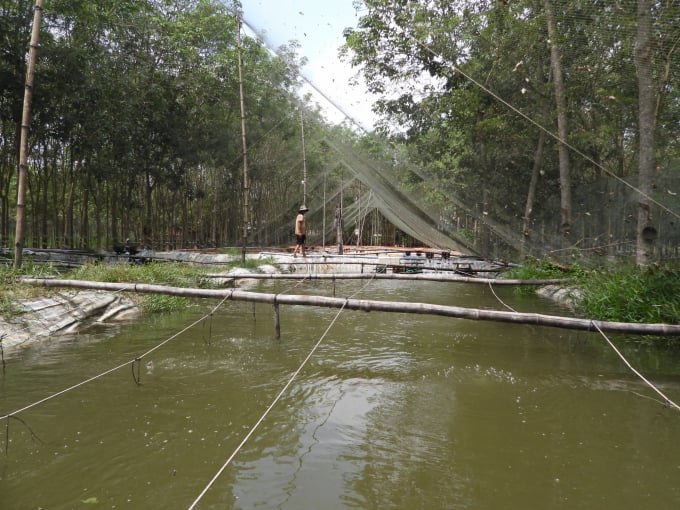
Mr. Giau's closed recirculating pond model for tire track eel raising in the border district of Tan Bien. Photo: Tran Trung.
While many people choose the easier path, breeding freshwater fish such as snakehead fish, grass carp, Eurasian carp, catfish, and even frogs and turtles, Mr. Nguyen Van Giau in Thanh Phuoc hamlet, Thanh Binh commune, Tan Bien border district has chosen tire track eel. Not only developing for his own good but Mr. Giau also openly shares seeds and effective farming methods with people inside and outside the locality to make a fortune together.
Meeting us at the farm, Mr. Giau shared with us his story about the journey with aquaculture.
“I was born and raised in An Giang, so aquaculture is as familiar as a friend. I once gained huge success thanks to shrimp farming, owning 100 ha of production area and earning billions of dong each year. But soon the situation went dire. Seeing the benefits of shrimp farming, other farmers soon followed the trend. Some of them, despite having zero experience, would risk it all for profits. Indiscriminate investment and farming caused the water to become heavily polluted, and disease spread like wildfire. From a shrimp pond owner, I became a debtor. I had to leave the land and wandered to many places, doing all kinds of jobs just to make ends meet.”
In the midst of constant struggle, he came to know of Tay Ninh - a land with a relatively complete irrigation system thanks to the Dau Tieng reservoir project, with potential and suitable natural conditions for aquaculture.
After many nights of thinking back and forth, he settled down in Tay Ninh and restarted his business. He decided to breed tire track eel seeds in a closed circulating floating pond system.
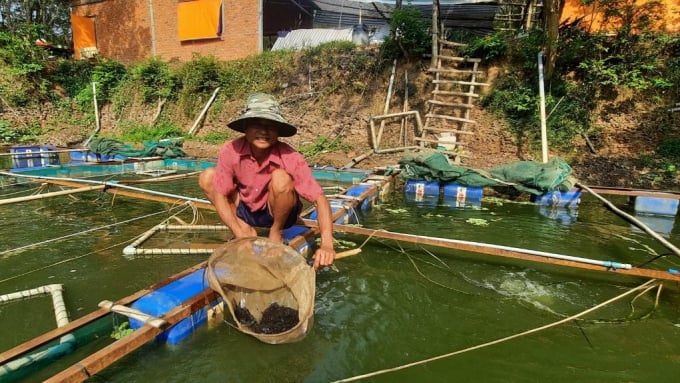
Tire track eel, also known as the "water ginseng" of the Mekong Delta, is thriving along with Mr. Giau in a new land. Photo: Tran Trung.
Mr. Giau said, “In the initial trials because I was inexperienced and the fish had not yet adapted to the new environment, by the time of harvesting, most of the fish had died. However, it is a blessing in disguise. Most of the remaining eels are healthy, and they self-bred to create the F1 generation similar to the parents."
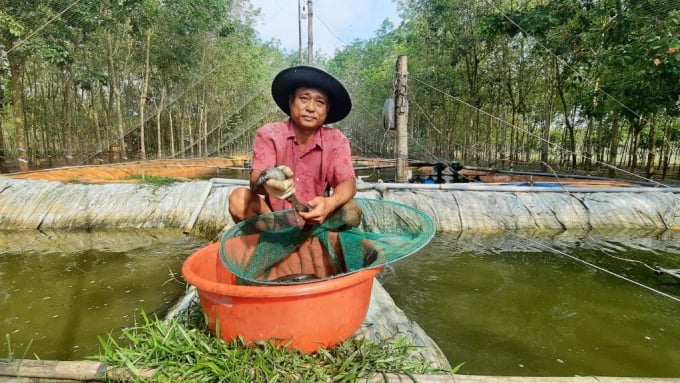
From only focusing on commercial farming, Mr. Giau found an effective breeding method to supply seeds to people inside and outside the locality. Photo: Tran Trung.
In order for the eels to grow well, before being put into spawning, the broodstock will be reared in separate ponds at an appropriate density while being accompanied by a high-nutrient food supply for approximately three months. The broodstock pond needs a fan system to increase the amount of dissolved oxygen in the water so that the eels can reach an optimal growth rate.
Mr. Giau also uses plastic net media, rolling them up and arranging them in rows within the pond to serve as a place for shelter. The eel density depends on the number of media.
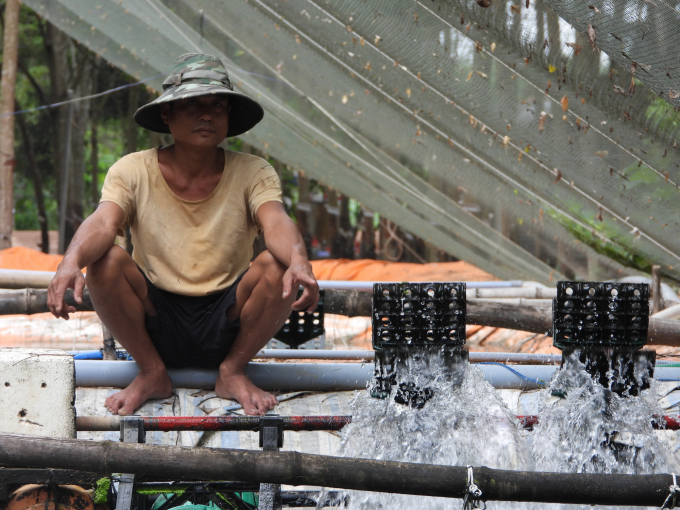
Mr. Giau combined his wealth of experience in shrimp farming with his tire track ell pond to create a sustainable development model. Photo: Tran Trung.
A special thing is that Mr. Giau's tire track ell raising model is designed in the form of "Garden - Pond - Pond". The ponds on the farm are designed in the rubber garden, so they are shaded by trees which help to regulate the pond temperature. To optimize the model, Mr. Giau also made additional nets to cover the entire pond area to prevent birds from harming eels or rubber leaves falling down and polluting ponds.
The farm also has a submersible pond with an area of about 3,000 m2 used to raise other common fishes to make full use of the excess food in the pond, which helps to reduce costs significantly. On the other hand, the wastewater in the submersible ponds is pumped to irrigate the rubber farm, helping plants grow well while reducing the amount of fertilizer required while still ensuring the latex output.
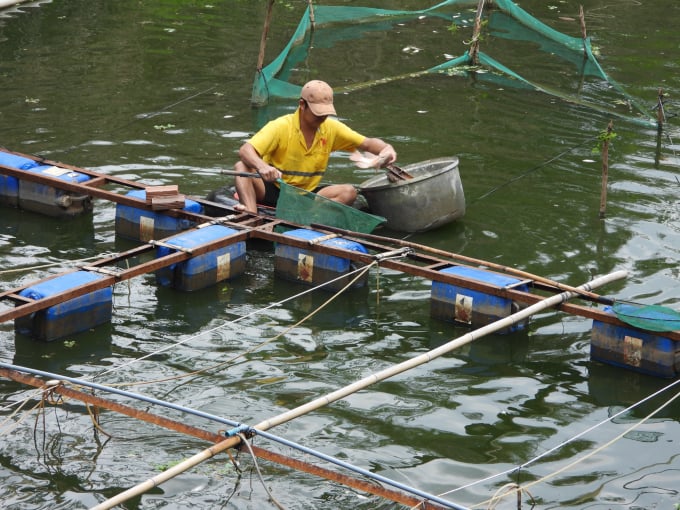
The "Garden - Pond - Pond" model, a unique and new model in Tay Ninh, has brought high income and has been replicated in surrounding areas. Photo: Tran Trung.
According to Mr. Giau, after seven months of implementing the model, a 250-300g commercial tire track eel can have a price of over VND 200,000/kg. The longer the fish is reared, the larger the weight and the higher the selling price. “I think this is one of the model’s biggest advantages because it limits the impact of the market. When the market is scarce, it is possible to raise fish to grow quickly to sell at a high price, and when the market is "bumped", there are still eels left to wait for the price increase, avoiding oversupply.”
Thanks to low loss rate (only approximately 2%), Mr. Giau can harvest 40 tons of eels per crop, bringing in a profit of billions of dong after deducting costs. “In my opinion, compared to other types of seafood, tire track eel remains the king of fishery product.”
Translated by Samuel Pham
/2025/11/27/3830-1-152901_403.jpg)
(VAN) Dong Nai is developing its key crop areas, expanding planting area codes, and applying high technology to increase the value of agricultural products, aiming at a green and sustainable agriculture.

(VAN) Tay Ninh’s livestock sector is undergoing a major transformation, applying high-tech, closed-loop circular models to build sustainable value chains.
/2025/11/26/3627-4-082628_818.jpg)
(VAN) From a small café on the red basalt highlands, Le Van Hoang started a business with clean coffee, building Enjoi Coffee into a symbol of organic agriculture in the Lam Dong plateau.
/2025/11/25/0045-1-135246_13.jpg)
(VAN) Ca Mau is researching a model of sea-encroaching embankments combined with viaducts and logistics service zones, aiming both to prevent erosion and create land funds for marine economic development.

(VAN) The information was shared at the seminar 'Urban Agriculture - Solutions for Developing Green Spaces,' organized by the Kinh te & Do thi Newspaper and the Biotechnology Center of Ho Chi Minh City.
/2025/11/19/4141-2-132831_216.jpg)
(VAN) One of Japfa's outstanding solutions is implementing digital transformation and artificial intelligence (AI) to optimize operations, enhance productivity, and advance sustainable development.
/2025/11/19/4847-1-093540_448.jpg)
(VAN) The Gia Lai Provincial People’s Committee had a working session with the delegation of the U.S. Department of Agriculture, the State of Idaho, and representatives of the State's leading enterprises.